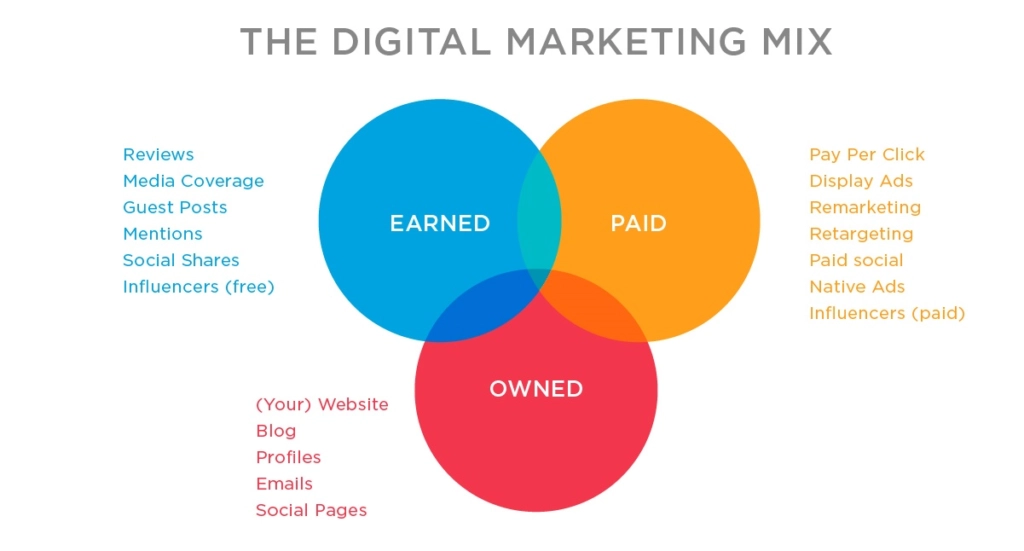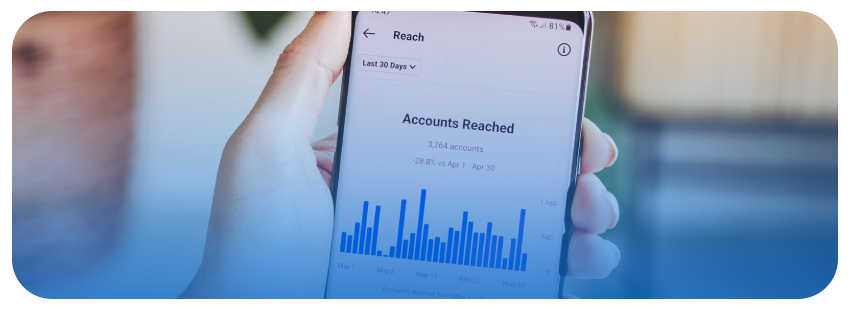If you want to target consumers directly, then paid media is one of the best ways to do it.
Paid media forms an essential part of most small business marketing strategies. It’s so effective because its lets you target your exact audience and get in front of them straight away. While strategies like SEO and organic content marketing take time to get results, paid media is instant.
In this guide, we’ll cover everything you need to know about paid media, how it works, and how you can run a paid media strategy for your business.
- What is Paid Media?
- Understanding Earned, Owned, and Paid Media
- How to Develop a Paid Media Strategy
What is Paid Media?
Paid media refers to any external paid placements that you use in your marketing strategy. This includes pay-per-click ads, display ads, boosted content, branded content, and more. If you promote a social media post or put out a search ad on Google, this is paid media.
Businesses use paid media to get them fast exposure to the right audience. This is one of the most crucial benefits of online advertising. Instead of relying on your audience to find your content organically, you can pay to get it placed in front of them.
There are many different types of paid media that exist. The main idea is that paid media takes place on channels that aren’t your own, such as ads on other websites and social platforms.
If you want to increase brand awareness and make more sales, then paid media is one of the most efficient ways to do this.
Understanding Earned, Owned, and Paid Media
When it comes to developing an online advertising strategy, you have three main options:
- Paid media
- Earned media
- Owned media
Combining each of these will help you create a powerful strategy for organic and paid media campaigns. But what exactly is each of them and how do they work?
Let’s break it down.
Earned Media
Earned media is any kind of organic media exposure that your brand has “earned” through word of mouth. This is the opposite of paid media, where you pay for media exposure. Instead, people share and expose your content for free.
Brands can generate earned media by creating and publishing awesome content, generating positive reviews, running a referral program, or releasing press releases.
Earned media is more difficult to generate and control, but it is incredibly powerful when you do get this exposure.
Owned Media
Owned media is your media. This is any published content that is under your control.
These days, any brand has the platforms available to them to generate its own media content. Owned media includes platforms like your blog and website, YouTube, podcasts, social media, and anything else you publish.
Owned media is essential for an SEO strategy. It’s all about adding value to your audience and establishing authority around your brand. The other great thing about owned media is that it’s free for you to publish.
Paid Media
Earned and owned media are all about getting your content discovered organically. Paid media, on the other hand, is when you pay to get your content to reach a lot of people.
This could be boosting a post on social media to get exposure or running ads on different websites and social platforms.
The great thing about paid media is that you can attract a lot of traffic to your content fast. The other great thing is that you can be very specific about what audience you target when running paid media advertising.
The downside? You have to pay for it.

Image: Sproutsocial
How to Develop a Paid Media Strategy
Before you just start running social media ads, it’s important that you have a clear strategy to make paid media work. Here are a few essential tactics and steps to take to make your paid digital marketing strategy a success.
Understand Your ROAS
The whole thing about paid media is that you have to pay for it. As any business owner knows, you’ll want to get more out of your campaigns than what you put in. This comes down to understanding your ROI and ROAS, which is the first piece of fundamental knowledge to grip before running paid media campaigns.
Return On Investment (ROI) refers to how much you get back from what you put into your paid media advertising. Return On Ad Spend (ROAS) refers to how much money your ads generate, minus how much you put into the ads.
So, if you spend $100 on paid media and sell $300 worth of products from the paid media campaigns, then you have a $200 ROAS. Good.
Alternatively, you could spend $100 on paid media ads and make $0 in sales from the ads. In this case, you end up with -$100. Not good.
So, when planning any kind of paid advertising campaign, you have to be careful about where you put your money. Otherwise, you could lose money (which you wouldn’t get with owned media).
Get your head around this first, then you can start to strategize your paid media campaigns.
Establish a Goal
Any paid media campaign needs to have a clear goal. This is essential because you need to know what you want to achieve with the money you spend on your ad.
What do you want your paid media ad campaign to achieve? Always start with the end in mind.
Generally, a paid media campaign is revolved around a conversion. This is the action that you want a user to take. For example, a conversion could be filling out a form on your landing page or purchasing a product.
The first step is to get this traffic to click on your ad. Then, the next step is to get them to take the action.
It’s essential to establish a clear goal from the start so that you can measure the effectiveness of your paid media strategy. This ties back to your ROAS, and you measure it by monitoring the right paid media metrics (more on this later).
Understand Your Audience
To run an effective paid media campaign, you need to know who you will be targeting. Your campaign is only going to be as effective as how well you address your audience.
The great thing about running social media paid ads is that social media platforms collect loads of data on their users. This means you can be very specific about who you target with your ads.
So, before you run a campaign, create detailed personas for your target audience. This should include their demographics and interests so that you can target them effectively.
There are other ad targeting options, such as retargeting visitors who have been on your site. However, targeting based on interests is always an effective approach for paid media.
Choose Your Paid Media Channels
There are many social media channels and sites out there where you can run your paid media strategy on. The one (or ones) that you choose need to be based on your campaign goal and your audience.
If we’re talking about social media advertising, the different social media channels all have different audiences with their own interests. It’s essential that the kind of ad you run matches the interests of these audiences.
Of course, it’s also important that you align the channel you use with your marketing budget. Make sure that you understand how much paid ads will cost and determine whether it’s worth it for your budget.
Paid media campaigns don’t have to be done on social media though. You can also run Google search ads, which can be incredibly valuable for your business. These paid search ads get your website to the top of search results on a PPC basis. There are many different types of Google ads format options available. Each one bids on keywords. Most search engine users click on the first result on the page – which would be your ad.
Create Your Ads
When creating your ads, it’s important that your ad looks natural where it’s placed. At the same time, it also needs to grab attention and attract clicks.
Create ads with catchy headlines, eye-catching imagery, and a strong CTA. Of course, the ad format you create will depend on the platform you’re using. Follow this guide to help you craft the perfect ad CTA.
To make sure your ads are optimized, try to A/B test them. This is when you run two variations of the same ad and test which one gets the best results. Now you can use the successful elements in your ads to help you achieve better results.
Whether it’s social media ads or search engine ads, even the smallest detail in the ad copy or image can make an enormous difference.
Set Dates and Launch
Now your paid ads campaign is ready to go. The next step is to set your start and end points for your campaign and launch it.
Keep an eye on the campaign and how it’s performing during this time. This might give you some insights into how to optimize your ad or your budget.
Analyze the Results
Once your paid media campaign is over, it’s time to look at how it performed. This is when you go back to your goal and your budget, and evaluate how successful your campaign was. It’s important to understand the right paid advertising metrics here to help you figure out what parts of your campaign worked and what parts didn’t.
Each platform you run paid ads on should have its own dashboard that offers insights into your paid media performance.
It’s important to understand your ad performance if you plan to run future campaigns. This will help you understand what worked and what didn’t so that your next paid media ads will be even more successful.
Conclusion
When it comes to the digital world, paid media is one of the best ways to boost your digital strategy. Successful paid media lets you reach a lot of people very quickly. Not just this, but you can reach your exact target audience.
This is way faster than traditional search engine results, and it’s what can take your social media or content marketing efforts to the next level.
So, if you’re struggling to get enough traction from your marketing content, then be sure to give paid media a try. With the right strategy, it could help your business to achieve awesome growth.
Related Content
- How to Develop an Awesome Content Marketing Plan in 10 Steps
- 15 Low-Cost Alternatives to Paid Advertising
- Beginners Guide to Using Paid Facebook Ads vs. Organic Facebook Ads
- The Beginner’s Guide to Facebook Ads for Small Business

